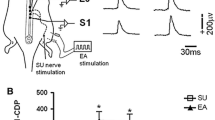Abstract
The parameters of conduction via afferent nerve fibers were studied in mice with streptozotocin-induced and genetically determineddiabetes mellitus (9- to 12-week-old animals; streptozotocin was injected into 5-week-old mice). Recording of spinal cord dorsal surface potentials evoked by stimulation of the sciatic nerve showed that within the studied time interval the mice of the two diabetic groups were characterized by a moderate decrease (by 7.9% and 5.8%, on average) in the conduction velocity for afferent volleys (measured according to the delay of the peak of positivity of a volley) and by a considerable increase in the duration of the positive phase of these volleys (by 36% and 33%, respectively, as compared with the values in intact animals). Therefore, the population of relatively “slow” group A afferent fibers becomes noticeably larger in the sciatic nerve of diabetic mice even at early stages of the pathology, but at the same time a considerable amount of the fastest-conducting (about 45–60 m/sec) fibers is still preserved. The changes in mice with diabetes of different etiology were very similar, in spite of different hyperglycemia levels in these groups. Possible factors determining diabetes-induced modifications of the conduction velocity via the nerve fibers are discussed.
Similar content being viewed by others
References
Diabetes Mellitus, Theory and Practice, H. Rifkin and D. Portae (eds.), New York, Amsterdam, London (1992).
S. Yagihashi, “Pathology and pathogenic mechanisms of diabetic neuropathy,”Diabetes Metabolism Rev.,11, No. 3, 193–225 (1995).
The Diabetes Control and Complication Trial (DCCT) Research Group, “Effect of intensive treatment on nerve conduction in the diabetes control and complications trial,”Annu. Neurol.,38, No. 6, 869–880 (1995).
A. V. Shmigol' and E. P. Kostyuk, “Mechanisms responsible for calcium signal formation in murine primary sensory neurons: their impairment by experimentally evoked diabetes,”Neirofiziologiya/ Neurophysiology,27, No. 5/6, 331–341 (1995).
M. Sonobe, H. Yasuda, T. Yisanaga, et al., “Amelioration of nerve Na+, K+-ATPase activity independently of myo-inositol level by PGE, analogue op-1206. aCD in streptozotocin-induced diabetic rats,”Diabetes,40, 726–730 (1991).
P. J. Dyck, E. H. Lambert, A. J. Windenbank, et al., “Acute hyperosmolar hyperglycemia causes axonal shrinkage and reduces nerve conduction,”Exp. Neurol.,71, 507–514 (1981).
S. Yagihashi, M. Kamijo, and R. Watanabe, “Reduced myelinated fiber size correlates with loss of axonal neurofilaments in peripheral nerve of chronically streptozotocin-diabetic rats,”Am. J. Pathol.,136, 1365–1373 (1991).
Author information
Authors and Affiliations
Additional information
Neirofiziologiya/Neurophysiology, Vol. 28, No. 4/5, pp. 173–178, July–October, 1996.
Rights and permissions
About this article
Cite this article
Kostyuk, E.P., Bulgakova, N.V. & Vasilenko, D.A. Parameters of conduction via afferent nerve fibers in mice with streptozotocin-induced and genetically determined diabetes. Neurophysiology 28, 135–139 (1996). https://doi.org/10.1007/BF02262774
Received:
Issue Date:
DOI: https://doi.org/10.1007/BF02262774




